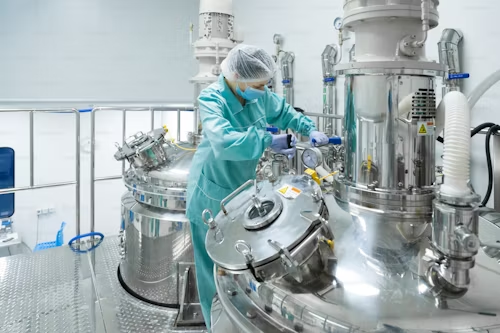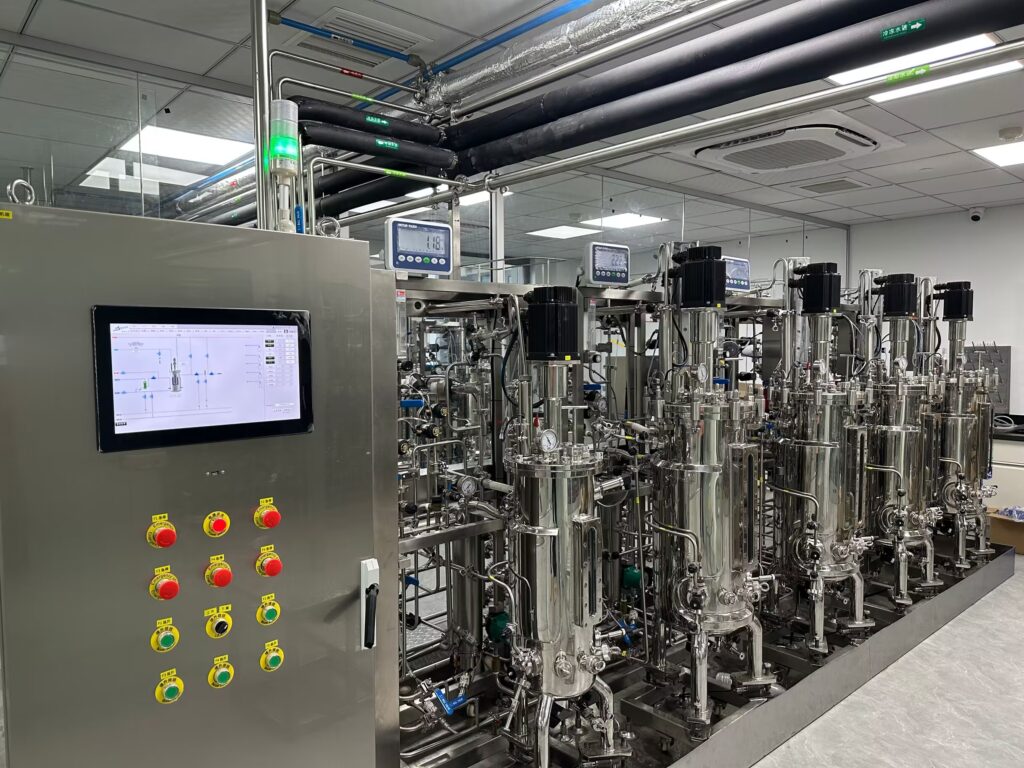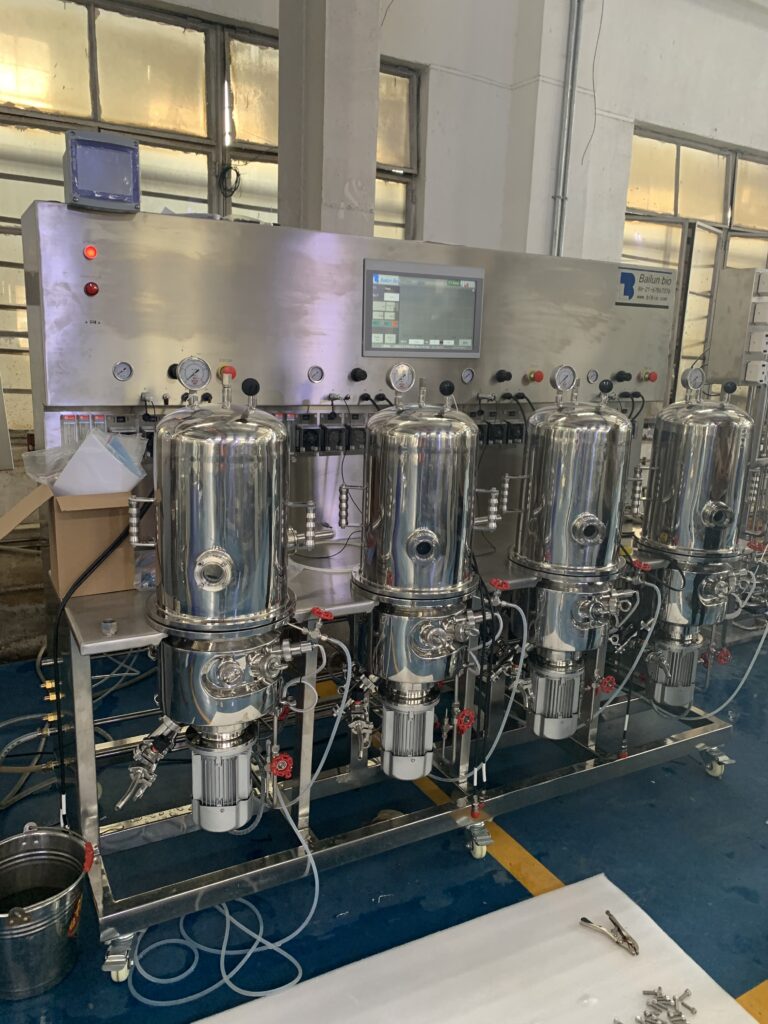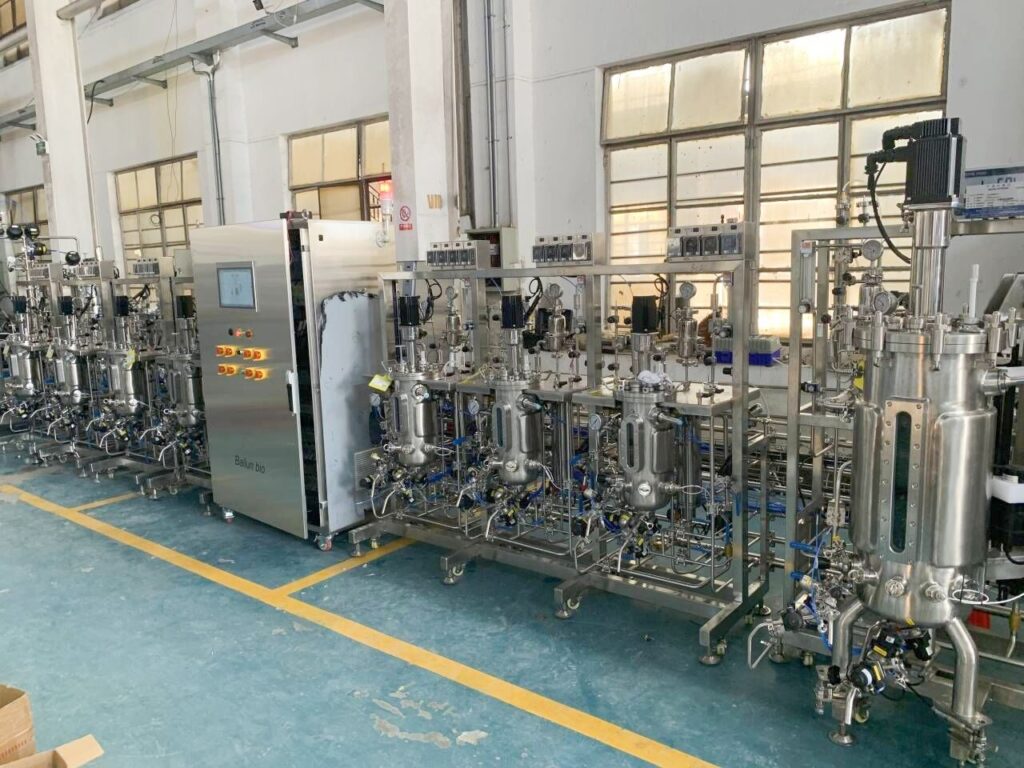
In case you’ve ever questioned how scientists choose which one to employ, this guide explains everything.
Let’s examine each of these procedures and discover why fed-batch bioreactors are frequently the preferred option in contemporary biomanufacturing and how they are particularly useful in intricate processes like the production of high-value goods, including biopharmaceuticals.
What is a Bioreactor in Microbiology?
A bioreactor is a container that offers the ideal conditions for the growth of cells like bacteria, fungi, or mammal cells so that they yield particular products.
Consider it a carefully regulated “breeding ground” for cells — where nutrients, pH, oxygen, and temperature are all carefully regulated. These regulated settings are vital to disciplines like genetic engineering, biochemistry, and microbiology. In these disciplines, they are necessary for the production of everything from vaccines to biofuels.
In order to enable scientists to develop microorganisms or cells on a wide scale, bioreactors are designed to scale up biological reactions. Many industries rely on bioreactor systems to produce biological products in large quantities.
So how do bioreactors work?

The 3 Primary Procedures for Operating Bioreactors
Batch, fed-batch, and continuous processing are the three primary procedures. Each has special benefits and are selected according to the requirements of the product.
These methods vary in terms of supplying nutrients and maintaining cell activity, affecting yield and process management. Here are three main strategies and explanations of why they are all essential to contemporary biomanufacturing.
1. Batch processing
In a batch process, a bioreactor is initially filled with cells and a predetermined quantity of nutrients. Over time, the cells use these resources to produce the required product (such as metabolites, proteins, or enzymes). The batch is “harvested,” and the production of a fresh one starts after the nutrients have been consumed.
Although batch processing is preferred because it is straightforward and easy to manage, it has drawbacks.
Batch processing advantages include:
- Control: Operators can effortlessly keep an eye on the entire process without having to make modifications all the time because everything is added at once.
- Decreased danger of contamination: Because batch systems are closed, there is a lower possibility of contamination, which is particularly helpful for bioreactors that are disposable or single-use.
- Setup ease: Compared to continuous systems, batch processes are easier to set up and require less sophisticated equipment.
The disadvantages of batch processing
- Limited yield: The cells stop producing when the nutrients run out. So you have to start over.
- Inefficiency: The entire process stops if one step is delayed, which lowers production.
- Increased downtime may result from re-sterilizing and cleaning equipment in between batches.
In summary, batch processing has a role, particularly in small-scale manufacturing. Nonetheless, fed-batch and continuous processes are far more efficient.

2. Fed-batch processing
Adding additives to a soup while it cooks is analogous to fed-batch processing. You start with a small amount of nutrients. Then, throughout the process, you progressively add more nutrients. This makes more control over cell development and product output possible.
By regulating the input of nutrients, a fed-batch bioreactor maintains the cells’ viability and productivity. This process is the preferred option for industrial enzymes and biopharmaceuticals since it is especially efficient in creating complicated bioproducts.
The unique features of fed-batch bioreactors
- Adaptable regulation of nutrient levels: A fed-batch system optimizes the production environment by allowing operators to feed cells as needed.
- Increased yields: Because nutrient levels can be maintained throughout time, fed-batch bioreactorsusually produce more than batch operations.
- Decreased buildup of harmful byproducts: Higher-quality products result from the gradual addition of nutrients, reducing the production of toxic byproducts (such as ethanol during yeast fermentation).
Fed-batch bioreactors are widely used in processes that require longer production time, such as the synthesis of enzymes, antibodies, and biofuel.
Moreover, high-density fed-batch cultures, which are necessary for manufacturing huge quantities of goods, are made possible by this technique.
A deeper look at fed-batch bioreactor applications
At the core of the biopharmaceutical sector are fed-batch bioreactors. For instance, fed-batch bioreactors are essential to the synthesis of monoclonal antibodies. These antibodies are used to treat illnesses like cancer.
Actually, almost 70% of the world’s monoclonal antibody manufacturing results from fed-batch bioreactor applications. Insulin, vaccines, and other therapeutic proteins are also made using this technique.
Additionally, fed-batch bioreactors are employed in the production of biofuels as cost-effectiveness depends on yield optimization.
3. Continuous processing
In a continuous process, waste and product are simultaneously evacuated from the bioreactor while nutrients are continually fed. With this method, the cells continue to produce the desired product at a constant rate, maintaining a steady state.
A soup pot with an endless supply of ingredients and a steady output is analogous to continuous processing. This technology is perfect for the production of industrial enzymes or biofuels that must be produced in large quantities.
Benefits of continuous processing
- Increased productivity: Continuous systems produce significantly larger amounts of product over time because the process never stops.
- Consistent product quality is maintained by the stable conditions that continuous bioreactors offer.
Continuous processing difficulties:
- Complexity: Continuous system operation necessitates ongoing observation to sustain stable circumstances.
- High cost: In general, the technology and equipment needed for continuous processes are more costly.
- Contamination risk: Particularly in pharmaceutical applications, contamination can be more difficult to control because the process never stops.
Because of its efficiency, continuous processing is becoming more and more popular for creating items that are in great demand. In biopharmaceuticals, it is less popular than fed-batch processing because of its complexity and expense.
Major Differences Between Batch, Fed-Batch, and Continuous Processes
The choice between batch, fed-batch, and continuous systems has a direct impact on output, whether you’re growing cells to make life-saving medications or fermenting microbes to produce bioethanol.
Here are the main distinctions between these techniques so you can see why fed-batch bioreactors are a particularly flexible and efficient choice in contemporary biomanufacturing.
1. Nutrient addition
In a batch process, all of the nutrients required for the full production cycle are added right at the start. The process comes to an end when the cells stop growing, and the nutrients are depleted. Although this method is straightforward, it only allows for the initial supply of nutrients to be used for production.
In contrast, a fed-batch bioreactor enables the addition of nutrients gradually during the process. Nutrients are added gradually and in controlled amounts rather than all at once, which keeps cells active and prolongs their growth, maximizing production.
In continuous processing, waste and products are eliminated as new nutrients are continuously added. This maintains the cells’ stability so they can keep proliferating and developing indefinitely without stopping.
2. Length of process
Because nutrients aren’t renewed throughout a batch process, its duration is constrained. Batch processing is brief and necessitates numerous restarts to sustain production because the process stops when the original nutrients are exhausted.
Fed-batch processes can last longer because nutrients are supplied as needed. Cells may continue to develop and generate the needed output without rapidly depleting resources. This allows for a longer production time.
As long as the bioreactor is properly maintained, continuous processes are intended to continue indefinitely. This configuration enables continuous manufacturing, which is perfect for products with high demand.
3. Regulation of cell growth
There is little control over cell proliferation in a batch procedure. There is no method to modify nutrient levels in response to cell activity because all nutrients are provided at the beginning. Growth slows down and eventually stops when nutrients become scarce.
By enabling the steady adjustment of nutrition levels, fed-batch bioreactors offer more control over cell development. Operators can prolong production time and maintain the optimal growth rate because of this flexibility, maximizing output.
Since waste and nutrients are continuously balanced, continuous processing provides the highest level of control. Although it necessitates sophisticated monitoring and changes, this steady-state environment offers a steady development rate and consistent product quality.
4. Product efficiency and yield
Since the batch process is limited by the initial nutrient supply, the product yield is moderate. Productivity may be slowed down by the requirement to restart the system after every batch.
Compared to batch processes, fed-batch systems produce more. Fed-batch bioreactors increase overall production by sustaining active cell growth for an extended period of time. This is particularly advantageous in high-stakes applications such as biopharmaceuticals.
Because manufacturing never stops, continuous processes are able to achieve optimal yields. Continuous processes maximize efficiency over time by maintaining a constant output. This is as long as waste disposal and nutrient levels are properly maintained.
5. Byproduct buildup
As nutrients are used up in batch operations, byproducts may build up and compromise the quality of the final product. Productivity may be limited because waste products accumulate until the batch is finished. After all, the entire cycle is completed with a single addition of nutrients.
Fed-batch bioreactors reduce undesirable byproducts by supplying nutrients gradually. In order to maintain a healthier cell environment and higher-quality products, operators regulate the feeding rate to avoid the accumulation of hazardous byproducts.
Continuous processes often accumulate the fewest byproducts because waste is continuously eliminated along with the product. This configuration aids in preserving ideal circumstances for cell division and proliferation.
6. Operational simplicity
Batch processing is an excellent option for smaller or simpler tasks because it is simple to set up and operate. There is less of a requirement for technical expertise because it doesn’t require sophisticated equipment or monitoring.
Batch-fed bioreactors are a little more complicated because they need regulated nutrient addition. They still achieve a nice balance, offering increased output without the demanding administration of a continuous system.
To sustain steady-state conditions, continuous processes (which are the most complex) need to be continuously monitored. They are difficult to run and need sophisticated systems to balance waste removal, fertilizer addition, and product quality.
7. Optimal uses
Batch process: For simpler or smaller-scale production requirements, such as preliminary research, early-stage product development, or modest production numbers.
Fed-Batch process: For the production of high-value, premium bioproducts such as biopharmaceuticals, enzymes, and biofuels, fed-batch bioreactors are the preferred option. Complex biomanufacturing processes are best suited for fed-batch systems due to their high productivity and adaptability.
Continuous process: Most preferred when steady, high-volume production is required for large-scale, high-demand applications like the manufacturing of industrial enzymes or biofuels.
The Role of Sub-Bioreactors in Modern Biomanufacturing
In many processes, cells are initially grown in an auxiliary bioreactor, known as the sub bioreactor, before being transferred to a larger primary bioreactor.
Sub bioreactors are used in fed-batch and continuous cultures to ‘prime’ cells to enable them to reach the growth phase as they are cultured in large volumes.
Subsembled sub-bioreactors decrease the rate of waste and increase the total effectiveness, helping to determine optimal conditions before moving to the next level.

Real-World Examples of Fed-Batch Bioreactor Process
The fed-batch bioreactor has a wide application in the food industry, biofuels, and medicinal industries. Let’s examine a few actual instances in more detail:
- Drugs: In manufacturing biopharmaceuticals with a focus on monoclonal antibodies applied in the treatment of cancer and autoimmune diseases, fed-batch processes are still a crucial component. For instance, it is possible to adapt the fed-batch method in order to increase the rate of production of antibodies.
- Biofuels: The fed-batch bioreactors are now important for the production of biofuels such as ethanol. This procedure can help to substantially raise the amount of fuel produced from a particular biomass thereby reducing costs.
- Food & beverage: Compared to other fermentation systems, fed-batch systems are ideal because control of fermentation rates ensures quality in the production of beer, yogurt, and more.
Why Fed-Batch Bioreactors Are Here to Stay
The fed-batch bioreactors offer an optimum level between the batch process and the continuous process. They remain suitable for all kinds of industries because of their relative general use and disposables bioreactor use.
In general, fed-batch bioreactors seem to provide a significant compromise between higher yields and more control without the problems of continuous processing.
The fed-batch systems can most effectively increase the cell density or product quality when nutrient concentration has to be altered. This is crucial because the heart of biomanufacturing is the production of medications, sustainable biofuels, and other items.
Advanced Bioreactor Systems and Biomanufacturing’s Future
The advances in bioreactor innovation are establishing novel potential for continuous and fed-batch systems in the future.
Bioreactors are evolving due to the automation of monitoring and AI, as well as through real-time data analysis, and thus provide further control over cell formation and product quality.
Subsequently, fed-batch systems and other single-use bioreactors or open systems are also being developed in terms of complexity. New modern ones have sensor systems to control the pH level, temperatures, and nutrients required, and the changes can be done instantly.
With such integration, smarter ‘bioreactors’ are being developed to further enhance yield and efficiency.
In summary
Ultimately, every bioprocessing technique has a role. Knowing your unique demands and limitations is crucial. Although the fed-batch bioreactor is currently the most popular option, it is not always the best option in all circumstances.
Remember that understanding and streamlining your process is more important for bioprocessing success than simply selecting the appropriate technology. The fundamentals are the same whether you’re using a contemporary single-use bioreactor or a conventional stainless steel setup.
From reliable batch procedures to advanced fed-batch bioreactor systems and promising continuous operations, every method advances biotechnology and enhances our quality of life
Keep in mind that there isn’t a one-size-fits-all approach to bioprocessing. The optimal procedure is the one that satisfies your unique requirements.
Improve Your Biomanufacturing with Bailun Technologies’ Premium Bioreactors!
Are you prepared to advance your biomanufacturing efforts? Select Bailun Technologies. We are a reliable partner in efficiency and innovation.
Whether you require state-of-the-art fed-batch, batch, or continuous bioreactors, Bailun Technologies provides cutting-edge systems designed for optimal accuracy and productivity.
When it comes to performance and quality, don’t accept less. Discover the ideal bioreactor for your requirements by visiting us today to view their whole selection.

